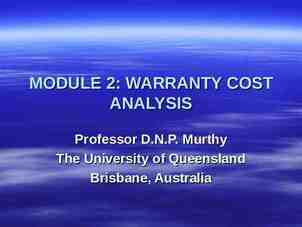Introduction to Parsing (adapted from CS 164 at Berkeley)
33 Slides330.50 KB
Introduction to Parsing (adapted from CS 164 at Berkeley)
Outline Parser overview Context-free grammars (CFG’s) Derivations Syntax-Directed Translation
The Functionality of the Parser Input: sequence of tokens from lexer Output: abstract syntax tree of the program One-pass compiler: directly generate assembly code – This is what you will do in the first assignment – Bali SaM code
Example if x y: z 1 Pyth: else: z 2 Parser input: IF ID ID : ID INT Parser output (abstract syntax tree): ELSE : ID INT IF-THEN-ELSE ID ID ID INT ID INT
Why A Tree? Each stage of the compiler has two purposes: – Detect and filter out some class of errors – Compute some new information or translate the representation of the program to make things easier for later stages Recursive structure of tree suits recursive structure of language definition With tree, later stages can easily find “the else clause”, e.g., rather than having to scan through tokens to find it.
Notation for Programming Languages Grammars: E int E E E E E*E E (E) We can view these rules as rewrite rules – We start with E and replace occurrences of E with some right-hand side E E*E (E)*E (E E)*E (int int) * int
Context-Free Grammars A CFG consists of – A set of non-terminals N By convention, written with capital letter in these notes – A set of terminals T By convention, either lower case names or punctuation – A start symbol S (a non-terminal) – A set of productions Assuming E N E E Y1 Y2 . Yn , or where Yi N T
Examples of CFGs Simple arithmetic expressions: E int E E E E E*E E (E) – One non-terminal: E – Several terminals: int, , *, (, ) Called terminals because they are never replaced – By convention the non-terminal for the first production is the start one
Key Idea 1. Begin with a string consisting of the start symbol 2. Replace any non-terminal X in the string by a right-hand side of some production X Y1 Yn 3. Repeat (2) until there are only terminals in the string 4. The successive strings created in this way are called sentential forms.
The Language of a CFG (Cont.) Write X1 Xn * Y1 Ym if X1 Xn Y1 Ym in 0 or more steps
The Language of a CFG Let G be a context-free grammar with start symbol S. Then the language of G is: L(G) { a1 an S * a1 an and every ai is a terminal }
Examples: S 0 also written as S 0 1 S 1 Generates the language { “0”, “1” } What about S 1 A A 0 1 What about S 1 A A 0 1A What about S ( S )
Derivations and Parse Trees A derivation is a sequence of sentential forms resulting from the application of a sequence of productions S Parse tree: summary of derivation w/o specifying completely the order in which rules were applied – Start symbol is the tree’s root – For a production X Y1 Yn add children Y1, , Yn to node X
Derivation Example Grammar E E E E * E (E) int String int * int int
Derivation in Detail (1) E E
Derivation in Detail (2) E E E E E E
Derivation in Detail (3) E E E E E*E E E E * E E
Derivation in Detail (4) E E E E E*E E int * E E E E int * E E
Derivation in Detail (5) E E E E E*E E int * E E int * int E E E int * E int E
Derivation in Detail (6) E E E E E*E E int * E E int * int E int * int int E E int * E int E in t
Notes on Derivations A parse tree has – Terminals at the leaves – Non-terminals at the interior nodes A left-right traversal of the leaves is the original input The parse tree shows the association of operations, the input string does not ! – There may be multiple ways to match the input – Derivations (and parse trees) choose one
AST vs. Parse Tree AST is condensed form of a parse tree – – – – operators appear at internal nodes, not at leaves. "Chains" of single productions are collapsed. Lists are "flattened". Syntactic details are omitted e.g., parentheses, commas, semi-colons AST is a better structure for later compiler stages – omits details having to do with the source language, – only contains information about the essential structure of the program.
Example: 2 * (4 5) Parse tree vs. AST E * T T F int (2) F * ( E E 2 ) 4 T T F F int (5) int (4) 5
Summary of Derivations We are not just interested in whether s L(G) Also need derivation (or parse tree) and AST. Parse trees slavishly reflect the grammar. Abstract syntax trees abstract from the grammar, cutting out detail that interferes with later stages. A derivation defines a parse tree – But one parse tree may have many derivations Derivations drive translation (to ASTs, etc.) Leftmost and rightmost derivations most important in parser implementation
Ambiguity Grammar E E E E * E ( E ) int Strings int int int int * int int
Ambiguity. Example The string int int int has two parse trees E E int E E E E E in t in E E t int int int is left-associative E
Ambiguity. Example The string int * int int has two parse trees E E int E E E E * E in t in E E t int int int * has higher precedence than * E
Ambiguity (Cont.) A grammar is ambiguous if it has more than one parse tree for some string – Equivalently, there is more than one rightmost or leftmost derivation for some string Ambiguity is bad – Leaves meaning of some programs ill-defined Ambiguity is common in programming languages – Arithmetic expressions – IF-THEN-ELSE
Dealing with Ambiguity There are several ways to handle ambiguity Most direct method is to rewrite the grammar unambiguously E E T T T T * int int ( E ) Enforces precedence of * over Enforces left-associativity of and *
Ambiguity. Example The int * int int has only one parse tree now E E T T * int int E T E in t in E E t int int * E
Ambiguity Impossible to convert automatically an ambiguous grammar to an unambiguous one Used with care, ambiguity can simplify the grammar – Sometimes allows more natural definitions – But we need disambiguation mechanisms Instead of rewriting the grammar – Use the more natural (ambiguous) grammar – Along with disambiguating declarations Most tools allow precedence and associativity declarations to disambiguate grammars Examples
Associativity Declarations Consider the grammar E E E int Ambiguous: two parse trees of int int int E E E int E int E E E int int E int Left-associativity declaration: %left ‘ ’ E E int
Summary Grammar is specified using a context-free language (CFL) Derivation: starting from start symbol, use grammar rules as rewrite rules to derive input string – Leftmost and rightmost derivations Parse trees and abstract syntax trees Ambiguous grammars – Ambiguity should be eliminated by modifying grammar, by specifying precedence rules etc. depending on how ambiguity arises in the grammar Remaining question: how do we find the derivation for a given input string?






































